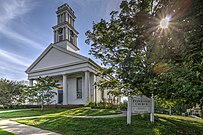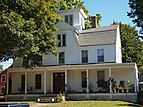United States historic place
| Colchester Village Historic District | |
| U.S. National Register of Historic Places | |
| U.S. Historic district | |
 A sign in front of the Cragin library signals the start of the historic district A sign in front of the Cragin library signals the start of the historic district | |
| Location | Roughly, along Broadway, Hayward, Linwood and Norwich Aves., Cragin Ct., Pierce Ln., Stebbins Rd., Main and S. Main Sts., Colchester, Connecticut |
|---|---|
| Coordinates | 41°34′28″N 72°19′54″W / 41.57444°N 72.33167°W / 41.57444; -72.33167 |
| Area | 75 acres (30 ha) |
| Architect | Multiple |
| Architectural style | Greek Revival, Federal, Colonial |
| NRHP reference No. | 94000254 |
| Added to NRHP | April 4, 1994 |
The Colchester Village Historic District encompasses most of the historic village center of Colchester, Connecticut. It is located at the junction of Route 16, Route 85, and Norwich Avenue (old Route 2). Roughly, the district extends to the northwest along Broadway Street (Route 85) as far as Jaffe Terrace; east along Norwich Avenue to just short of Pleasant Street; south along South Main Street to just north of Hall Hill Road; west along Linwood Avenue (Route 16) to just east of Kmick Lane. The historic district was listed on the National Register of Historic Places (NRHP) in 1994.
 Civil War monument on the Green (1875)
Civil War monument on the Green (1875) Colchester Federated Church, 60 Main St
Colchester Federated Church, 60 Main St Hayward Fire Co. Museum
Hayward Fire Co. Museum A home on Hayward Avenue
A home on Hayward Avenue
The Colchester Town Green is located at the center of the district. Several commercial, residential and civic buildings mostly from the 19th century, surround the green, with the Colchester Federated Church in the Greek Revival style and the Bacon Academy (built in 1803 and separately listed on the NRHP) being the dominant structures. The Hayward House (built in 1767 and separately listed on the NRHP) is located on Hayward Avenue across the street from the green and is now being used as a bed and breakfast. Wheeler Block, the original town hall and also listed separately on the NRHP, is located across the green to the south on Norwich Avenue.
Colchester was incorporated in 1698 and was at first a dispersed agricultural community. The village center formed around the town's first colonial meeting house and burying ground, with the area's economic importance later cemented by its location as a crossroads of several early 19th century turnpikes. Bacon Academy was founded in 1803 as the region's first secondary school, and the town was home to the first Masonic lodge in the region (founded 1782). In the second half of the 19th century, the village benefited from the rise of small industries, prompting the construction of a number of commercial buildings, including the fine Second Empire Wheeler Block.
See also
References
- ^ "National Register Information System". National Register of Historic Places. National Park Service. March 13, 2009.
- ^ "NRHP nomination for Colchester Village Historic District". National Park Service. Retrieved January 23, 2015.
External links
- [REDACTED] Media related to Colchester Village Historic District at Wikimedia Commons
- Clouette, Bruce; Cronin, Maura (December 3, 1993). "National Register of Historic Places Registration: Colchester Village Historic District". National Park Service. and accompanying 15 photos
| U.S. National Register of Historic Places | |
|---|---|
| Topics | |
| Lists by state |
|
| Lists by insular areas | |
| Lists by associated state | |
| Other areas | |
| Related | |